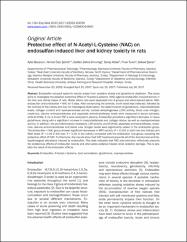Protective effect of N-Acetyl-L-Cysteine (NAC) on endosulfan-induced liver and kidney toxicity in rats

Göster/
Erişim
info:eu-repo/semantics/openAccessTarih
2017Yazar
Beceren, AyferŞehirli, Ahmet Özer
Omurtag, Gülden Zehra
Arbak, Serap
Turan, Pınar
Şener, Göksel
Üst veri
Tüm öğe kaydını gösterKünye
Beceren, A., Şehirli, A. Ö., Omurtag, G. Z., Arbak, S., Turan, P. ve Şener G. (2017). Protective effect of N-Acetyl-L-Cysteine (NAC) on endosulfan-induced liver and kidney toxicity in rats. International Journal of Clinical and Experimental Medicine, 10(7), 10031-10039.Özet
Endosulfan-induced systemic toxicity arises from oxidative stress and glutathione depletion. This study aims to investigate the possible protective effect of N-acetyl-L-cysteine (NAC) against endosulfan-induced toxicity in the liver and kidney tissue of rats. Wistar albino rats were separated into 4 groups and administered saline, NAC, endosulfan and endosulfan + NAC for 5 days. After euthanizing the animals, trunk blood was collected, followed by the removal of the kidney and liver for histological observation, the determination of glutathione, malondialdehyde levels, collagen content and myeloperoxidase activity. Lactate dehydrogenase (LDH) activity, blood urea nitrogen, creatinine, alanine aminotransferase and aspartate aminotransferase levels were measured in serum samples, while 8-OHdG, IL-1b, IL-6 and TNF-alpha were analyzed in plasma. Endosulfan provoked a significant decrease in tissue glutathione, along with a significant increase in malondialdehyde and collagen status, as well as myeloperoxidase activity. In addition, the pro-inflammatory mediators, LDH activity, and 8-OHdG, aspartate aminotransferase, creatinine, alanine aminotransferase and blood urea nitrogen levels were significantly raised in the endosulfan group. The endosulfan + NAC group showed significant decreases in MPO activity (P < 0.001 in both liver and kidney) and MDA levels (P < 0.01 in the liver, P < 0.05 in the kidney) compared with the endosulfan only group, revealing the protective effect of NAC. Furthermore, the results show that NAC treatment prevents all of the biochemical and histopathological alterations induced by endosulfan. This data indicates that NAC administration effectively prevents the deleterious effects of endosulfan toxicity and attenuates oxidative hepato-renal oxidative damage. This is possibly the result of its antioxidant effects.
WoS Q Kategorisi
Q4Scopus Q Kategorisi
Q3Kaynak
International Journal of Clinical and Experimental MedicineCilt
10Sayı
7Koleksiyonlar
- Makale Koleksiyonu [285]
- Scopus İndeksli Yayınlar Koleksiyonu [6648]
- WoS İndeksli Yayınlar Koleksiyonu [6722]

















